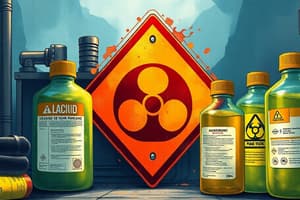Podcast
Questions and Answers
What is the process called when an employer considers if there are any other, less toxic chemicals that could perform a similar job?
What is the process called when an employer considers if there are any other, less toxic chemicals that could perform a similar job?
product substitution
What does the skull-and-crossbones pictogram in the hazard communication standard refer to?
What does the skull-and-crossbones pictogram in the hazard communication standard refer to?
fatal or toxic
_______ develop as a result of long-term exposure to dangerous materials like silica.
_______ develop as a result of long-term exposure to dangerous materials like silica.
chronic health effects
Symptoms of pallor, tiredness, weakness, insomnia, headache, and nervous irritability are associated with exposure to which substance?
Symptoms of pallor, tiredness, weakness, insomnia, headache, and nervous irritability are associated with exposure to which substance?
Signup and view all the answers
How should loose lead particles be removed from protective clothing?
How should loose lead particles be removed from protective clothing?
Signup and view all the answers
Sanding, sawing, cutting, or grinding masonry materials can often produce which hazardous substance?
Sanding, sawing, cutting, or grinding masonry materials can often produce which hazardous substance?
Signup and view all the answers
To find the proper firefighting measures for a hazardous substance on a worksite, employees should refer to the __________.
To find the proper firefighting measures for a hazardous substance on a worksite, employees should refer to the __________.
Signup and view all the answers
The hazard communication standard includes which of the following?
The hazard communication standard includes which of the following?
Signup and view all the answers
The hazcom requires all of the following to be included on chemical labels except safety data sheets.
The hazcom requires all of the following to be included on chemical labels except safety data sheets.
Signup and view all the answers
Employers must ensure that workers' lead exposure does not remain above the permissible exposure level for more than ___ hours.
Employers must ensure that workers' lead exposure does not remain above the permissible exposure level for more than ___ hours.
Signup and view all the answers
Work with asbestos is divided into four classes, ranging from class ___ to class ___ in ascending order of hazard.
Work with asbestos is divided into four classes, ranging from class ___ to class ___ in ascending order of hazard.
Signup and view all the answers
The minimum temperature at which a liquid produces enough vapor to form a flammable mixture is called ___.
The minimum temperature at which a liquid produces enough vapor to form a flammable mixture is called ___.
Signup and view all the answers
Study Notes
Employer Responsibilities
- Product substitution involves considering less toxic alternatives for chemicals in the workplace.
Hazard Communication
- The skull-and-crossbones pictogram indicates fatal or toxic substances under the hazard communication standard.
- The hazard communication standard requires correct labeling and safety data sheets for chemicals used.
Health Effects
- Chronic health effects result from long-term exposure to hazardous materials, such as silica.
- Symptoms associated with lead exposure include pallor, tiredness, weakness, insomnia, headache, and nervous irritability.
Safe Handling of Lead
- Loose lead particles should be removed from protective clothing by vacuuming, not shaking or brushing.
Silica Risks
- Activities like sanding, sawing, cutting, or grinding masonry materials often generate silica dust, a significant health hazard.
Firefighting Measures
- To determine proper firefighting measures for hazardous substances, employees should consult the safety data sheets.
Chemical Labeling
- The hazard communication standard encompasses various requirements, including labeling and safety data sheets.
- Chemical labels must include specific information; however, safety data sheets themselves are not to be included on labels.
Exposure Limits
- Employers are responsible for ensuring workers' lead exposure remains below the permissible exposure limit for no more than 8 hours.
Asbestos Work Classes
- Work involving asbestos is categorized into four classes, from class one (lowest hazard) to class four (highest hazard).
Flammability
- The flashpoint is defined as the minimum temperature at which a liquid emits enough vapor to form a flammable mixture.
Studying That Suits You
Use AI to generate personalized quizzes and flashcards to suit your learning preferences.
Description
This quiz focuses on key concepts related to employer responsibilities, hazard communication, and the health effects of hazardous materials in the workplace. It covers essential topics such as safe handling of lead and silica risks, along with proper firefighting measures. Test your knowledge and ensure a safer work environment.




